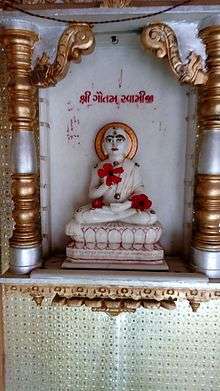Indrabhuti Gautama
Indrabhuti Gautama or Gautam Swami was the Ganadhara (chief disciple) of Mahavira, the 24th and last Jain Tirthankara of present half cycle of time.[1] He is also referred to as Gautama Gandhara or Gautama Swami.
| Gautama Ganadhara | |
|---|---|
.png) Miniature of Indrabhuti Gautama seated, in the typical Śvetāmbara monastic dress and holding a rosary, 15th century | |
| Personal information | |
| Parents |
|
| Part of a series on |
| Jainism |
|---|
 |
|
Jain prayers |
|
Ethics |
|
Major sects |
|
Texts |
|
Festivals
|
|
|
Life
Gautama was the senior-most of 11 ganadharas (chief disciples) of Mahavira.[2] In Jain traditional accounts, he is believed to have gained Kevala Jnana (omniscience) immediately after the moksha (liberation) of Mahavira.[3] He was succeeded by Sudharma who is believed to have gained omniscience after a further 12 years.[3]
According to the elaboration of Debate with the Ganadhara by Jinabhadra, the learned Brahmin Gautama summoned the gods to a great sacrifice but instead they flew off to hear Mahavira preaching at his second samavasarana near by.[4] In fury, Gautama confronted Mahavira in debate, as did ten other brahmins in succession, with the fordmaker converting them all by a demonstration, underpinned by his claim to omniscience.[4] According to Svetambara texts, Gautama had a meeting with Keśī (ganadhara of Parshvanatha).[5] Svetambaras write Gautama's name in new account books as a sign of auspiciousness in the new year.[6]
Gautama is connected with prosperity as he fed some monks using his magical powers.[6]
_Wellcome_L0034107.jpg)


Gautama is mentioned in the Exposition of Explanations, as an interpreter of Mahavira.[4] It is further mentioned that they have been friends in their previous incarnations and will attain moksha in the one which they are now.[4]
See also
References
Citations
- Teerthankar mahaveer aur unki acharya parampara by Dr. Nemi chandra shastry, Sagar, 1974 vol-1-4.
- Natubhai Shah 2004, p. 38.
- Natubhai Shah 2004, p. 39.
- Dundas 2002, p. 37.
- von Glasenapp 1999, p. 35.
- Dundas 2002, p. 39.
Sources
- Dundas, Paul (2002) [1992], The Jains (Second ed.), Routledge, ISBN 0-415-26605-X
- Shah, Natubhai (2004) [First published in 1998], Jainism: The World of Conquerors, I, Motilal Banarsidass, ISBN 978-81-208-1938-2